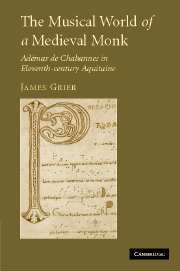Book contents
- Frontmatter
- Contents
- Preface
- A note on the musical examples and the edition
- Chapter 1 Introduction: Adémar de Chabannes and Saint Martial de Limoges
- Chapter 2 Music scribe
- Chapter 3 Compiler
- Chapter 4 Editor
- Chapter 5 Composer
- Chapter 6 Singer
- Chapter 7 Conclusion: The success of the apostolic campaign
- Appendix A Manuscripts with Adémar's music hand
- Appendix B Adémar's original compositions
- Bibliography
- Index of chants
- Index of manuscripts
- General index
Chapter 1 - Introduction: Adémar de Chabannes and Saint Martial de Limoges
Published online by Cambridge University Press: 22 September 2009
- Frontmatter
- Contents
- Preface
- A note on the musical examples and the edition
- Chapter 1 Introduction: Adémar de Chabannes and Saint Martial de Limoges
- Chapter 2 Music scribe
- Chapter 3 Compiler
- Chapter 4 Editor
- Chapter 5 Composer
- Chapter 6 Singer
- Chapter 7 Conclusion: The success of the apostolic campaign
- Appendix A Manuscripts with Adémar's music hand
- Appendix B Adémar's original compositions
- Bibliography
- Index of chants
- Index of manuscripts
- General index
Summary
We know more about the musical activities of Adémar de Chabannes than of any other medieval musician, with the possible exception of Guillaume de Machaut. This knowledge derives from a bizarre series of historical accidents that caused the abbey of Saint Martial de Limoges to become the setting for the strange drama that became the latter phase of Adémar's life. First, Adémar turned to Saint Martial, initially as the place of his advanced education but later and more than once as a refuge from a difficult situation at his home abbey of Saint Cybard in Angoulême, about a hundred kilometres distant from Limoges. Second, his choice of Saint Martial for these purposes was hardly providential: an ancestor on his father's side of the family, Aimo, had been abbot there in the first half of the tenth century (while his brother Turpio simultaneously held the office of bishop of Limoges), and his father's two older brothers, Adalbertus and Roger, were monks at the abbey. Adalbertus, the oldest, became deacon, while Roger, the middle brother, filled the post of cantor and tutored his nephew Adémar during his advanced studies.
Third, Adémar was also drawn to Saint Martial because the abbey enjoyed considerable prestige, and, perhaps most important for a scholar of wide-ranging interests like Adémar, it possessed an outstanding library.
- Type
- Chapter
- Information
- The Musical World of a Medieval MonkAdémar de Chabannes in Eleventh-century Aquitaine, pp. 1 - 36Publisher: Cambridge University PressPrint publication year: 2006



